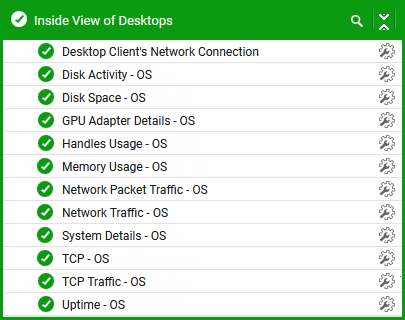The Inside View of Desktops Layer
The Outside View of VMs layer provides an “external” view of the different VM guests - the metrics reported at this layer are based on what the VMware host is seeing about the performance of the individual guests. However, an external view of the VM guest operating system and its applications may not be sufficient. For instance, suppose one of the disk partitions of the guest operating system has reached capacity. This information cannot be gleaned from host operating system. Likewise, bottlenecks such as a longer process run queue or a higher disk queue length are more visible using an internal monitor. Internal monitoring (from within the guest operating system) also provides details about the resource utilization of different application(s) or processes.
The tests mapped to the Virtual Desktop layer provide an "internal" view of the workings of each of the guests - these tests send probes into each of the guest operating systems to analyze how well each guest utilizes the resources that are allocated to it, and how well it handles user sessions, TCP traffic, and network loading.
By default however, clicking on the Virtual Desktop layer, does not list the associated tests. Instead, Figure 1 appears, which displays the current state of all virtual desktops that have been configured on the monitored ESX host.

Figure 1 : Figure 4.1: The current state of the desktops configured on the KVM VDI server host that is monitored
To return to the layer model of the KVM VDI server and view the tests mapped to the Virtual Desktop layer, click on the component layers link in Figure 1. The tests depicted by Figure 2 then appears.

Figure 2 : The tests associated with the Inside View of Desktops layer of a KVM VDI server
Almost all the tests depicted by Figure 2 have already been dealt with in the section on the KVM server model. The tests that are specific to the KVM VDI server model are alone discussed.



